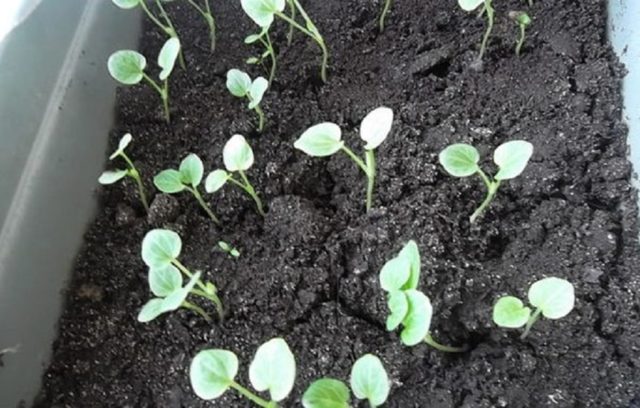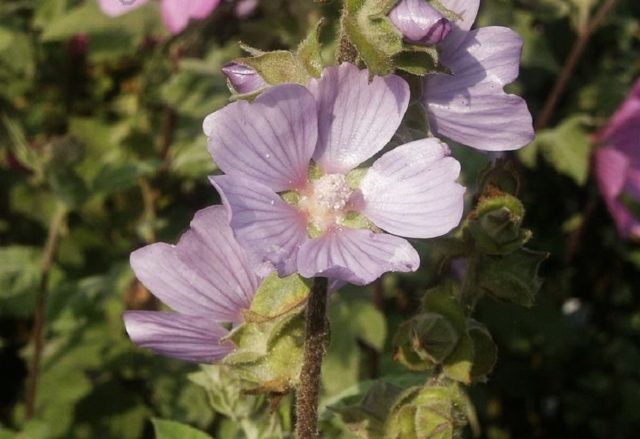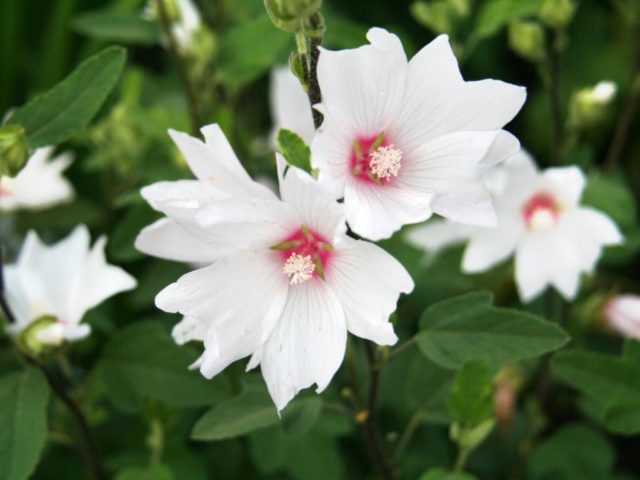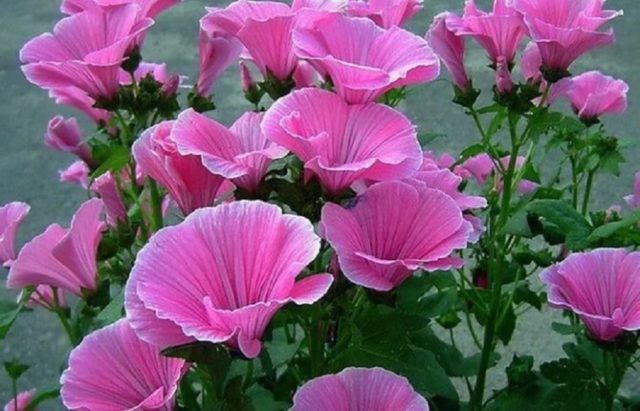Content
The Thuringian Khatyma (Lavatera thuringiaca), also known as dog rose and puppeteer, is a perennial herb. It is used for various purposes, for simple cultivation in the garden and in folk medicine. Outwardly, the flower is very attractive, moreover, it has an analgesic, anti-inflammatory effect.

Due to the medicinal properties of Hutma Thuringian, it is used to treat various diseases.
Description of the perennial Thuringian Lavater
Perennial Lavatera Thuringian is a pubescent tall herbaceous plant with a gray-green color. In height, it can be from 30 cm to 2 m. The stem and leaves are powerful, branching is abundant. The leaf plates are large with a heart-shaped base and rounded at the edges, alternate, 3 or 5-lobed. The rhizome is well developed, often growing to a depth of 1.5 m.
The flowering period is July-August. At this time, the bush is covered with pink large, up to 10 cm in diameter, single flowers with numerous stamens, fused into a common column with a pistil. On the stem, they are located singly in the leaf axils, and closer to the apex form a loose brush. Pink petals are notched in shape, 5 pcs. on one flower.
At the end of flowering, disc-shaped fruits are formed in the form of a ball of "flour". When ripe, they dry out and disintegrate into separate seeds of 20-25 pieces.
Where and how the thuringian hautma grows
Hutma Thuringian grows in natural conditions more often in groups, in gardens it can easily take root as a single specimen. Planting is usually carried out along roads and in personal plots. In nature, the plant can be found in meadows and steppes, rocky slopes, deforestation and even in the mountains at an altitude of up to 2000 m above sea level.
The natural habitat is considered to be North America, Australia, Europe, as well as Central and East Asia. You can also meet the Thuringian hautma in Ukraine, in the southern and central zone of Russia, in the Caucasus, Altai and in Western Siberia.
Varieties of the Thuringian hautma
The perennial plant khatma has a number of foreign varieties. They are highly decorative, which makes them ideal for growing in gardens. The most interesting varieties are:
- Lilac Lady (Lilac Lady) is a plant with large flowers of a pale lilac color, on the petals of which longitudinal lines of a darker shade are visible.
The long-term hautma of the Lilak Lady variety is considered one of the most unpretentious to care for.
- Barnsley Baby (Barnsley Baby) has very nice looking white or light pink flowers with a brighter core.
The bush of this variety is compact and low, and the flowers of a light shade stand out effectively against the background of the green mass.
- I catcher (Eye Catcher) has beautiful bright flowers of rich pink color.
On the flowers of the Ay Catcher variety, dark longitudinal veins can be clearly seen, diverging from the center.
Application in landscape design
Despite the fact that the Thuringian hautma is a herbaceous plant according to the photo and description, it is still high enough that it can be planted in single plantings. In the landscape, compact bushes are often used for ennobling a curb, planting along a path or a fence. It will look great near a gazebo or garden bench. In addition, unusual flower arrangements with the Thuringian hautma are often made, because it goes well with many flowers of medium height.
How the thuringian hautma reproduces
The main breeding method of the Thuringian hautma is by seeds. Under natural conditions, after the end of flowering, fruits ripen, which begin to dry out and separate into seeds. They crumble and germinate over time. At home, 2 planting methods are used:
- sowing seeds directly into open ground;
- seedling method.

The seedling method of growing Thuringian hautma is used quite rarely, since the flower is unpretentious
The healing properties of the Thuringian hautma
Khatyma Thuringian is a rather popular plant in folk medicine, and all thanks to its healing properties. All parts of the flower are successfully used to treat various diseases.
The leaves of khatma contain a large amount of vitamin C and alkaloids, which makes it possible to use the plant in the treatment of colds. And the presence of organic acids, starch and enveloping substances (mucus) in the roots makes perennial a good remedy for diarrhea and gastritis.
Application of the Thuringian hautma
The chemical composition of the hautma allows this plant to be used in a variety of areas. The presence of useful microelements makes it a good medicine in folk medicine, and the high rate of the flower's honey content is an undoubted plus for beekeepers.
But, like any remedy, the Thuringian hautma, regardless of its medicinal properties, also has contraindications for use, so you should not abuse drugs based on this plant.
Application of the Thuringian hautma
Perennial hatyma Thuringian has an enveloping, anti-inflammatory and softening effect. This effect allows the use of various infusions and decoctions of this plant for the treatment of colds.
A decoction of the leaves is recommended for treating upper respiratory tract infections. Root tinctures are often used for diarrhea and other not very serious diseases of the gastrointestinal tract. The balm, made from leaves, stems and roots, helps well with skin diseases, having an anti-inflammatory and healing effect.
In beekeeping
Large, beautiful flowers with a delicate aroma become an attractive object for bees, which makes this plant very popular with beekeepers.
The perennial khatma blooms from mid-summer to early autumn, abundantly emitting nectar and pollen. At the same time, the nectar productivity of the plant is approximately 200 kg per hectare, which makes it possible to obtain about 500 kg of pollen from 1 hectare.
Honey from this flower is obtained with excellent taste, very aromatic and light.
In other areas
In addition to its high importance in medicine and the cultivation of Thuringian hautma for obtaining high-quality honey, it is also used for livestock farming. In this case, the plant acts as feed for cattle.
And the high tensile strength, exceeding the parameters of hemp twine, allows the plant to be used for the manufacture of various ropes and ropes.
The decorativeness of the plant makes it popular among gardeners and landscape designers.
Conclusion
Khatyma Thuringian is considered a good decorative flower for growing in garden plots. For knowledgeable people, this plant has value as a universal medicine for the treatment of colds, coughs and some gastrointestinal problems.











